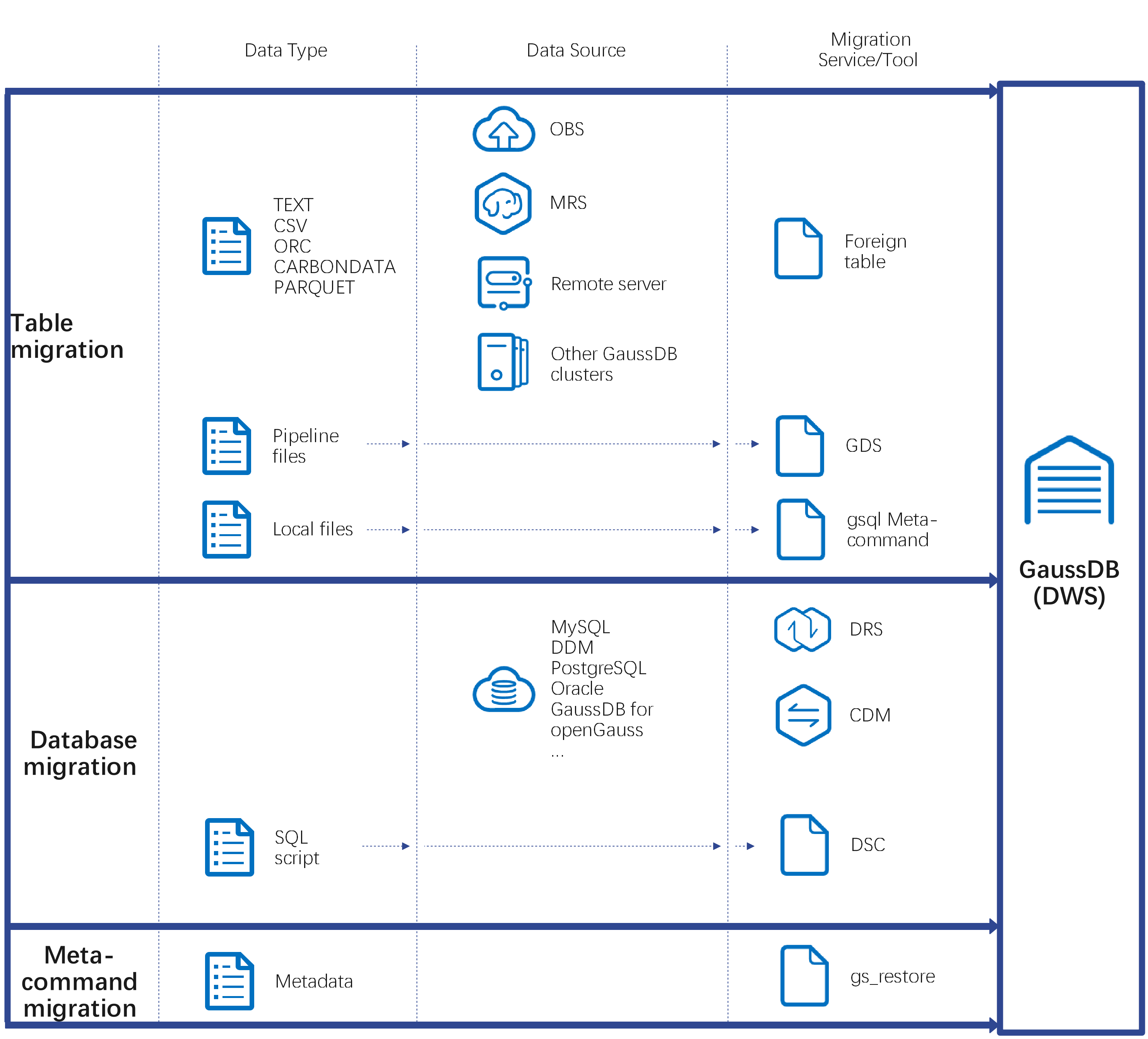Data Migration to GaussDB(DWS)
GaussDB(DWS) provides flexible methods for importing data. You can import data from different sources to GaussDB(DWS). The features of each method are listed in Table 1. You can select a method as required. You are advised to use GaussDB(DWS) with Data Replication Service (DRS), Cloud Data Migration (CDM), Data Ingestion Service (DIS), and Data Lake Factory (DLF). DRS is used for real-time data synchronization, CDM is used for batch data migration, DIS is used for stream data ingestion, and DLF orchestrates and schedules the entire ETL process and provides a visualized development environment.


- DRS, CDM, OBS, and MRS are cloud services.
- GDS, DSC, and gs_restore, and gs_dump are internal tools.
Import Method |
Data Source |
Description |
Advantage |
|---|---|---|---|
OBS |
You can import data in TXT, CSV, ORC, or CarbonData format from OBS to GaussDB(DWS) for query, and can remotely read data from OBS. It is recommended for GaussDB(DWS). |
This method features high performance and flexible scale-out. |
|
Servers (remote servers) |
Use the GDS tool provided by GaussDB(DWS) to import data from the remote server to GaussDB(DWS) in parallel. Multiple DNs are used for the import. This method is efficient and applicable to importing a large amount of data to the database. |
||
MRS (HDFS) |
Configure a GaussDB(DWS) cluster to connect to an MRS cluster. In GaussDB(DWS), read data from the HDFS of MRS. |
This method features high performance and flexible scale-out. |
|
- |
Two GaussDB(DWS) clusters can access data of each other. You can use foreign tables to access and import data across GaussDB(DWS) clusters. |
This method is applicable to data synchronization between multiple GaussDB(DWS) clusters. |
|
- |
GDS is used for data transit to implement data synchronization between multiple clusters. |
This method is applicable to data synchronization between multiple GaussDB(DWS) clusters. |
|
Local files |
Unlike the SQL COPY statement, the \copy command can read data from or write data into only local files on a gsql client. |
This method is easy to operate and suitable for importing a small amount of data to the database. |
|
Other files or databases |
When you use Java to develop applications, the CopyManager interface of the JDBC driver is invoked to write data from files or other databases to GaussDB(DWS). |
Data is directly written from other databases to GaussDB(DWS). Service data does not need to be stored in files. |
|
|
The real-time data synchronization of the DRS allows you to copy data from a data source to GaussDB(DWS) to implement real-time data flow of key services. This method focuses on the synchronous import of tables and data. |
This method supports data import from abundant data sources and is easy-to-operate. |
|
Databases, NoSQL, file systems, and big data platforms |
CDM can migrate various types of data in batches between homogeneous and heterogeneous data sources. CDM migrates data to GaussDB(DWS) using the copy method or the GDS parallel import method. |
This method supports data import from abundant data sources and is easy-to-operate. |
|
Databases, NoSQL, file systems, and big data platforms |
For details, see the documents of the third-party ETL tool. GaussDB(DWS) provides the DSC tool to migrate Teradata/Oracle scripts to GaussDB(DWS). |
Provides abundant data sources and powerful data conversion capabilities through OBS. |
|
|
gs_dump exports a single database or its objects. gs_dumpall exports all databases or global objects in a cluster. To migrate database information, you can use a tool to import the exported metadata to a target database. |
This method is applicable to metadata migration. |
|
SQL, TMP, and TAR file formats |
During database migration, you can use the gs_restore tool to import the file exported using the gs_dump tool to a GaussDB(DWS) cluster. In this way, metadata, such as table definitions and database object definitions, is imported. The following definitions need to be imported:
|
Feedback
Was this page helpful?
Provide feedbackThank you very much for your feedback. We will continue working to improve the documentation.See the reply and handling status in My Cloud VOC.
For any further questions, feel free to contact us through the chatbot.
Chatbot








